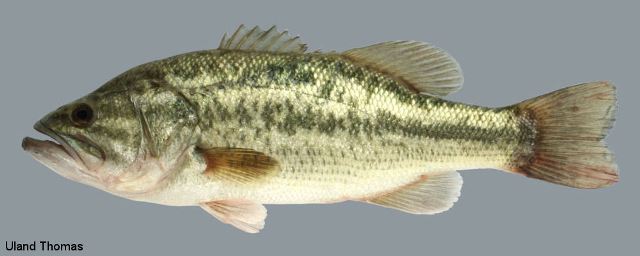Largemouth Bass
(Micropterus salmoides salmoides)

The largemouth bass is a popular sport fish. It is native to Ohio and can be found in every county in the state.
Description
Largemouth bass have a very large mouth that extends beyond the rear edge of the eye when it is closed. This characteristic distinguishes it from the smallmouth and spotted bass where the back of the mouth does not extend past the eye. Young largemouth bass do not have an orange tail like juvenile smallmouth and spotted bass. The largemouth also has a black stripe that extends down the side of the body. Spotted bass also have a dark lateral stripe but differ from the largemouth in having rows of dark spots below the lateral stripe and a tooth patch on their tongue.
Habitat and Habits
Largemouth bass can adapt to many environments but prefer relatively clear non-flowing waters with some aquatic vegetation. They are found in nearly every lake, reservoir, and pond in Ohio. However, in flowing streams and rivers largemouth bass are typically out numbered by smallmouth bass and in southern Ohio spotted bass
Reproduction and Care of the Young
Largemouth bass usually spawn between mid-April and mid-June. Nests are constructed by the male in one to six feet of water. The female lays between 2,000 and 20,000 eggs in several different nests; one nest can contain eggs from several females. The male guards the eggs until they have hatched. Young largemouth feed on microscopic animals until they reach one inch in length. At this time, they begin eating freshwater shrimp, midge larvae, and other small animals.